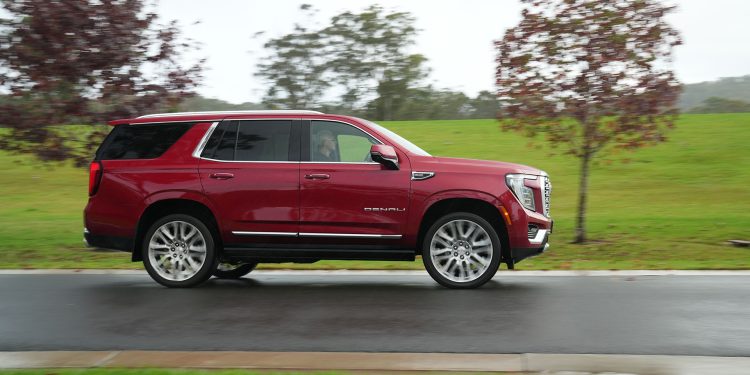GMC Yukon Denali – First Drive
Words NZ Autocar | Images GMSV
GMC won’t exactly be a household name for most folk from the Antipodes. However, with the Yukon Denali launching in May, people will soon notice the presence of this large SUV on the streets.
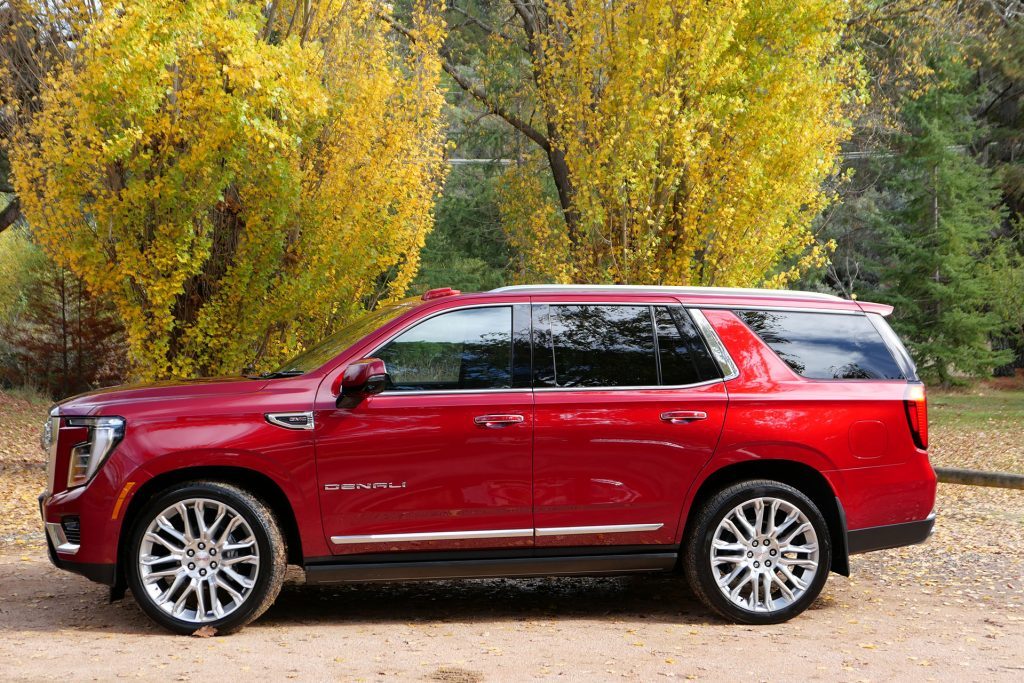
GMSV is bringing in the top example of the Yukon, and it’s dotting down in a niche occupied by very few indeed, at least on our side of the ditch. There’s really only one like-sized and like-priced rival in the eight-seat area. And that’s the LR Defender 130 with the eight-seat option.
As to its name, the Yukon borrows the title from the rugged territory in the Northwest of Canada. With switchable 4wd, high and low ratio, height adjustable air suspension, and LSD, this has off-road credentials. It’s build for taming the rugged wilds.

Meantime, the Denali suffix literally means ‘the tall one’, as in Mt McKinley. And at 1.95m in height, the descriptor is apt, for a vehicle at any rate. Contributing to its elevated status are 24-inch wheels, said to be the largest standard rims on any passenger vehicle in Australasia. It’s so tall that part of the package includes deploying and retracting sidesteps. Handgrips also help with ascent.
Other key dimensions include length of just under 5.4m, a wheelbase exceeding 3m and width of over 2m. And that’s with the mirrors retracted. Little wonder then there’s room in the rear for eight adults, and still 722L of luggage space left over with all seats in use. Fold the third row away and it rises to 2056L. With all the seats flat in the back, there’s not far off 3500L of luggage space (3480L). That’s 1000L more than its LR rival.
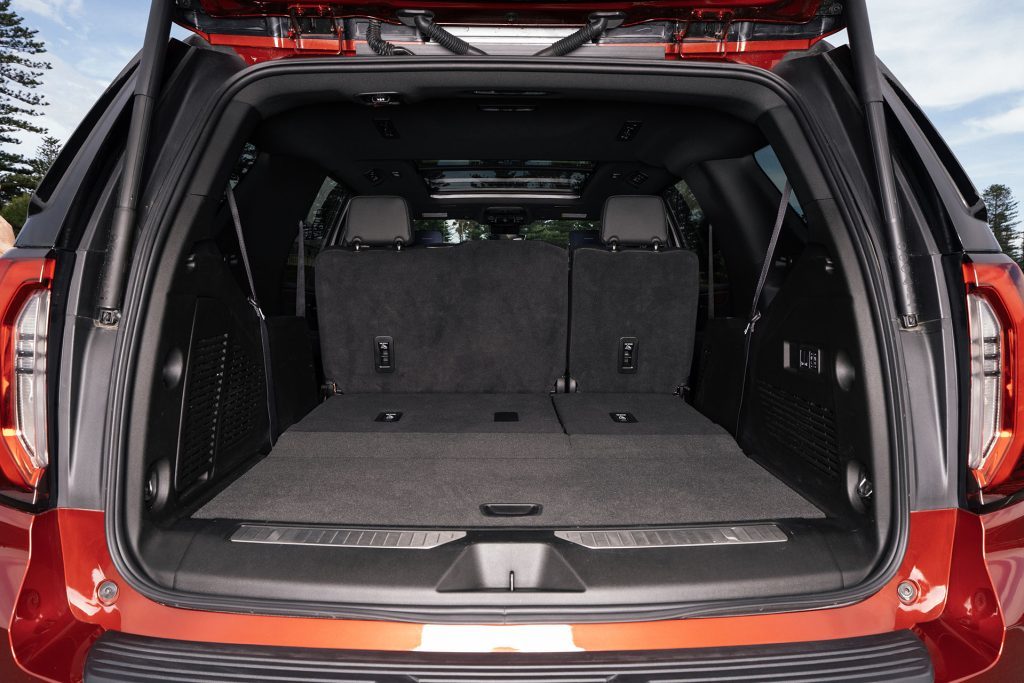
And while we’re on numbers this tips the scales at 2810kg. That’s in part due to its body-on-frame platform, the T1XX underpinnings shared with Silverado, among others. Which happens to imbue it with the best braked towing figures in the class at 3628kg, a specific number right? Turns out it’s 8000 pounds for US residents. So another best in class claim. That compares with a figure of 3000kg for the Defender 130.
Behind that whopper of a chromed grille lies a 6.2L naturally aspirated V8 that distributes power via a 10-speed automatic transmission. The engine, which features displacement on demand (Active Fuel Management) and infinitely variable valve timing, generates power of 313kW and torque of 624Nm. That’s sufficient, evidently, for a sprint time to 100 of 7.2sec. Which seems conservative to us, at least by the stopwatch. What it did feel was unbelievably relaxed in its demeanour; nothing bothers this. Even with a trailer hitched up, it just gets on with the job and doesn’t need much in the way of revs in everyday use. GMC rates mean fuel use at 12.8L/100km. We saw low 14s when cruising on day one, and on the way up to Sydney a mean of 11.3L/100km.
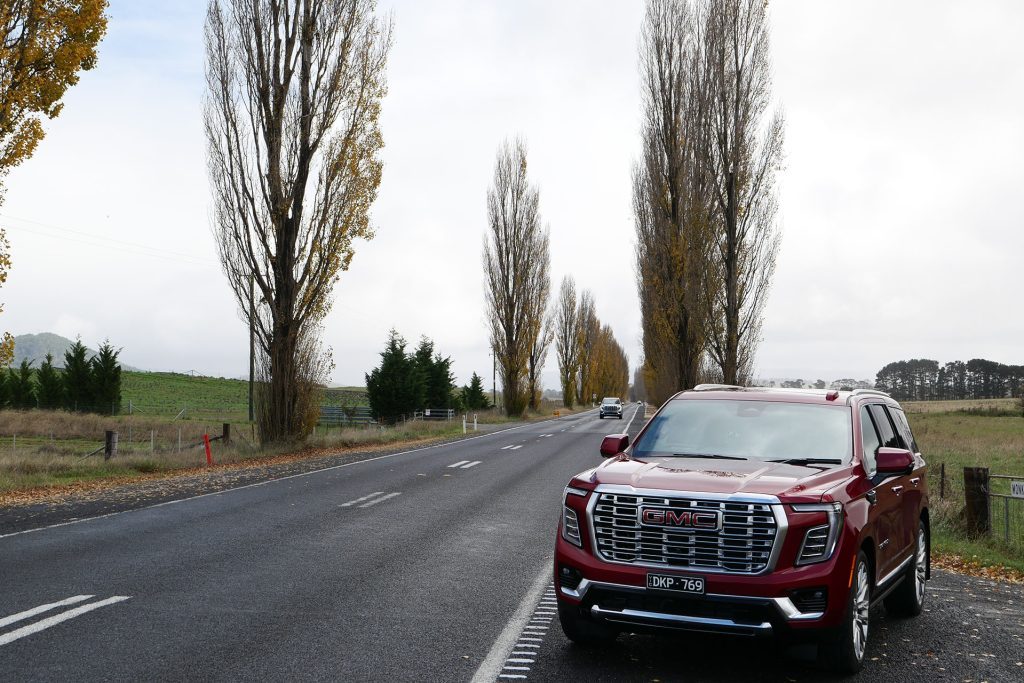
This is a rather imposing machine to behold. You ride high here. Driving behind small cars, they seem almost toy-like. Either side of the square-rigged grille are L-shaped DRLs and LED headlights, while at the rear are four square exhaust outlets, a pair each side. Mirrors are body coloured and so too wheel arches. In profile, those 24-inch rims dominate proceedings.
Inside is also impressive, though not so much in a modern idiom; the central screen isn’t master and commander here, though it is big. Instead of minimalism there are switches and buttons galore. The central screen is essentially for infotainment purposes.

Expect swathes of gloss black finishes, a few woody bits, oddly in brown fading to black, and powered, heated and ventilated front seats finished in perforated leather. A few semi-soft surfaces were unexpected. There’s evidently 42 inches of screens if you add ‘em all up. Centre stage is a 16.8inch portrait offering, while the driver gets an 11.8inch configurable screen and there’s a 15.8inch head-up display. In the rear are 12-inch screens for the outer seat occupants, and also seat heating and independent AC controls. While there’s no native navigation, AA and ACP are wirelessly integrated to the Bose 13-speaker infotainment system. We missed not having Traffic Sign Recognition.
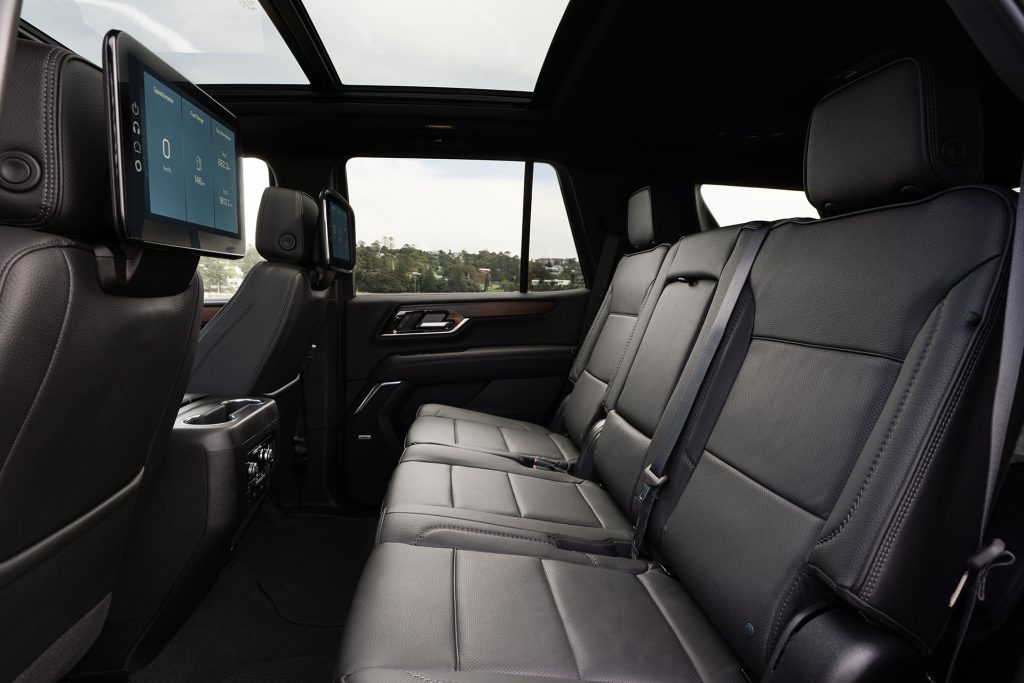
Other standard kit includes a dual-panel panoramic sunroof with tilt and slide function and powered blind beneath, a powered fifth door and opening window, a shifter on the right side of the steering column, pushbutton start, two seat memories, an auto retracting steering column and wireless charging.
Four drive modes comprise Normal, Sport, Off-Road and Tow/Haul. Mention of which, this has 11 camera views, several optimised for towing, a standard tow hitch and 12-pin harness, and trailer sway control. There’s a digital mirror view too, which compensates for the outer rear headrests that impede visibility through the rear view window. A rear wash wipe unit proved handy on the day when rain was ever present. So for an SUV it genuinely ticks the major practicality and spec boxes.
We had a really rather generous time behind the wheel. First a three-hour road trip from Canberra to the NSW border and then another similar jaunt up the coast for the return trip home out of Sydney.
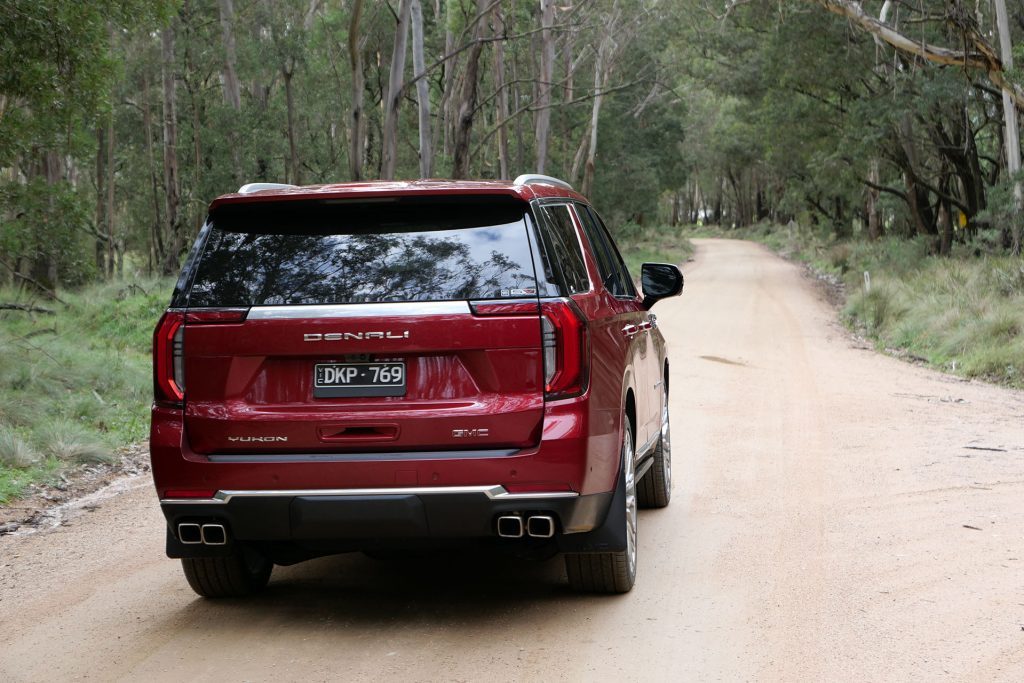
People who buy big SUVs have a love affair with V8s, at least in America, according to GMSV. And you can see why. They sound good, provide easy-going power and lope along on the open road without any real sense of effort. A 10-speed auto helps, though for the life of us we couldn’t activate the paddle shifters. Turns out there’s a button on the wheel for that, labelled L. Why not M for manual which makes way more sense?
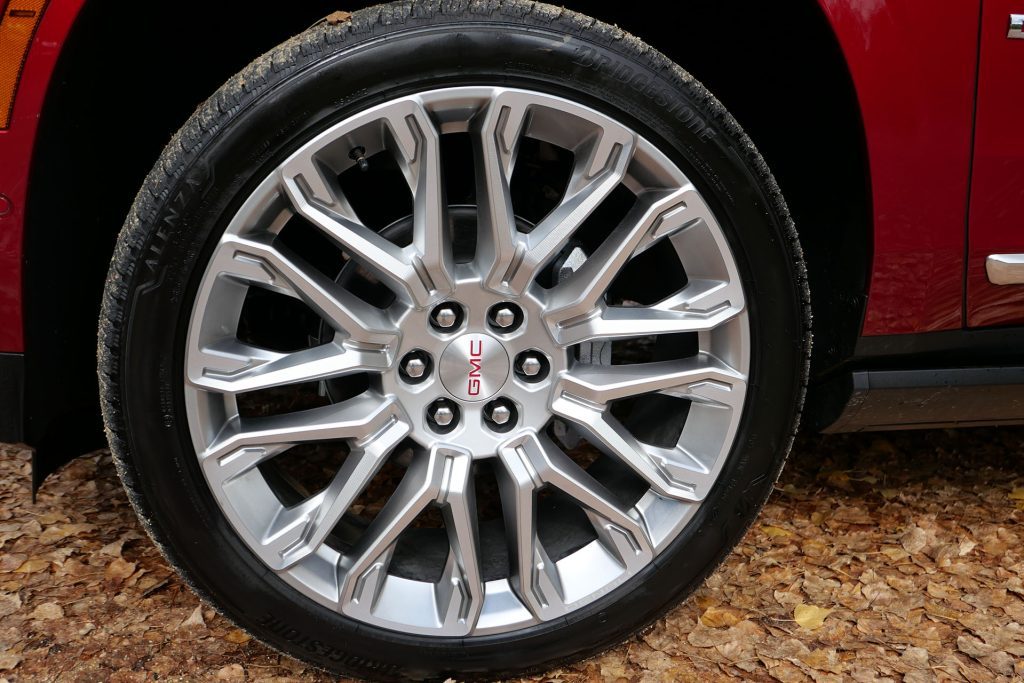
And on the button thing, this is almost the polar opposite of the EV norm where buttons seem to be a dirty word. Sure, it takes a little time to acclimate but the same can be said for confounded central screen controllers. Many of the buttons are on the right side of the dash, by the door, while those below the central screen are for the heating and ventilation. We rather liked the heated wheel. And the standard tints for the rear half of the car make it look a bit presidential. Not so noticeable in a visual sense is the acoustic glass but it sure is quiet on road as a result. Not that SUVs aren’t quiet anyway but this one is hushed quiet.
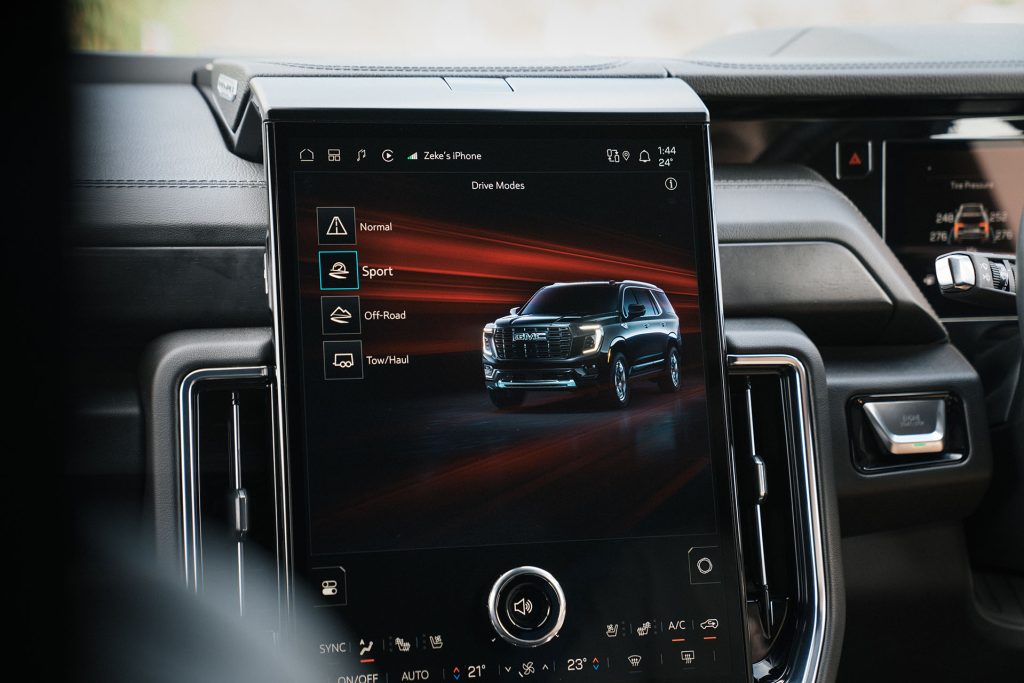
Handling and ride? It’s not often body on frame efforts are impressive in the ride department but this sure is. All that weight carried high means, despite the big beefy tyres, that this needs to be driven sensibly. It’s important to set speed accurately before the bends but provided you do that it handles fine, given its weight, and feels planted. Despite the wet conditions, 2wd (to the rear natch) was fine. We tried AWD as well but it felt well grounded as a rear driver so reverted back. It was the same on the 20km of dirt roads we plied; the TC and ESP handled any minor loss of traction issues adeptly. Some slight oddities; you can scarcely here the indicators in action, and the seat vibes if you cross a white line on the side of the road. That’s sure to rouse drowsy drivers.
As to rivals? In Australia a few of the Land Cruisers offer eight seat options but not in New Zealand where Hyundai Palisade does and so too CX-90 and Nissan Patrol but these aren’t as big or generous with space inside.
The main opposition comes from the eight-pew Land Rover Defender 130. It too has a V8, a twin turbo mild hybrid and is quicker, with a sprint claim of 4sec. It is also 5.4m long but isn’t as generous in the luggage capacity or towing stakes. Prices are similar, the GMC slightly less at $184,990. The Yukon Denali goes on sale in May and is backed by a three-year, 100,000km warranty.


